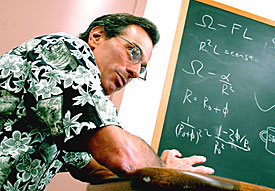 |
|
JACOB KONST/Arizona Daily Wildcat
|
The physics department head Daniel Stein said he was happy that UA has been ranked among the top 21 undergraduate physics department programs in the nation.
|
|
|
By Ashley Nowe
Arizona Daily Wildcat
Monday, September 29, 2003
Quarks are the smallest subatomic particles, nothing escapes black holes, the speed of light is constant, and UA physicists are being recognized for keeping undergraduates interested in all this.
The National Task Force on Undergraduate Physics recognized the UA as one of the top 21 undergraduate physics programs in the country.
After discovering that in the last decade, physics bachelor's degrees dropped by 25 percent nationwide, the task force observed physics departments across the nation, to see what was done differently.
"It is a variety of things that reinforce our success," said Daniel Stein, department head of physics. "We make students an important part of our program."
Success is attributed to three factors: a well-built program that is both challenging and supportive, positive faculty attitudes towards changing and developing course activities, and student engagement.
"It doesn't happen overnight," said Fulvio Melia, the associate department head of physics. "The past nine years we have given the department a lot of attention."
Evaluating student's level of understanding so that courses can encompass students at all levels is one reason the UA physics department has succeeded, Stein said.
"We look at our student's introduction level, but we also evaluate them year to year," Melia said. "We don't lose our students through the cracks, because we understand that students may have different needs and we have teachers that can meet those needs."
The physics department has a "personal response system," which allows students to vote on classroom issues, making it easy for the teacher to gauge student's ability, said physics professor J.D. Garcia, who was also a member of the task force.
"I am from Connecticut and one of the things that I looked for in a physics program was enthusiasm in the professors," said physics freshman Tory Carr. "It's teachers like Professor Garcia that make it awesome. He is so into what he does and will do anything to get you into it too."
Student involvement in evaluation of curriculum and teacher performance also set the department aside, according to the task force report.
The physics department has a "curriculum committee" composed of mostly seniors, which judges the teachers and the course work, allowing the department to get student feedback.
"We like to get input from people that have been through it," Stein said. "I understand that it all looks different from the other side and we want to know what works and what doesn't."
The third key to keeping students interested in physics is allowing students to get involved with research, Stein said.
"One of the reasons I came to the UA is for the physics program," said physics sophomore Chris Carlson. "The things we learn are very pertinent to modern physics, and I want to get into research and the UA does modern research."
The UA allows students at all levels to participate in research, which gives students a hands-on experience and also strengthens faculty-student relationships, Garcia said.
"It is important to get students turned on to physics and research can do this," Garcia said. "What's great is that any student can participate in this frontline research."
After being critiqued five years ago by other science departments on campus, which said the UA had a lackluster physics department and teaching was not what it should be, the department underwent a lot of changes to make it better, Stein said.
New faculty members were hired, research grants more than doubled and student outreach programs went to high schools to promote the UA physics department, Stein said.
"It is an honor for the UA," Garcia said. "It comes from caring a lot about teaching and involving the students in our own learning."

